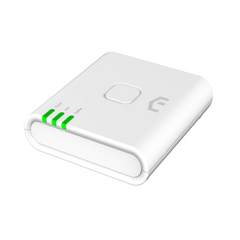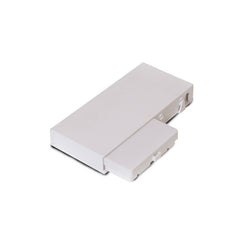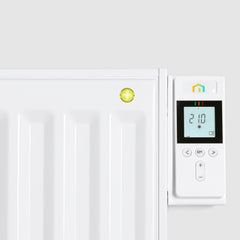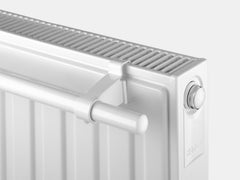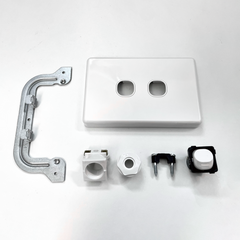
How Efficient Are Electric Radiators?
We're often asked by our customers how efficient our electric heaters are to run. Choosing between electric radiator heaters, like our Purmo Plus Series radiators, regular convection electric panel heaters and split systems, can be a tough call. But understanding what makes each type efficient can make the decision easier, along with other factors like the magic of thermostats, duty cycles and whether your house is leaking heat like a sieve.
Resistive heating and heat pumps – working out efficiency
Let's take a look at the difference in energy efficiency between heaters first. Heat pumps, for instance, such as wall-mounted reverse-cycle air conditioners used in heating mode, can be very efficient space heaters. That's because heat pumps work by shifting heat from the outside to the inside, or vice versa for cooling. They can hit efficiencies of 200 to 300 per cent or more, which is like producing two to three times more heating energy than the electrical energy they use.
Electric resistance heaters, like our Purmo Plus Radiators, are 100 per cent efficient at converting electricity to heat, meaning that a 1000W heater running at full power for one hour will use 1kWh (kilowatt hour) of electricity. These heaters work by passing an electric current through a resistive element, like a coil or wire, which generates heat. In an oil heater this coil sits in thermally conductive oil. It's a simple heating type that keeps things warm and snug. Be careful though, some systems with low thermal mass or not-so-great thermostats can spike energy use – more on that soon.
Based on this information people will often assume that a split system is going to be two to three times cheaper to run. However, it's a little bit more complicated than that.
What really impacts efficiency
People are often confused about electrical efficiency and real-world running costs – it's easy to mix up the two when it comes to heating.
While we've talked about how effectively an electric heater converts electrical energy into heat, the other thing to consider is what it really costs to keep the heater running for a stretch. Think beyond that 24 cents for a whole kilowatt-hour used in an hour. Factors such as temperature control and how long you keep the heater running make a big difference too.
Why thermostats matter
The quality of the thermostat can be a big deal for energy consumption. A quality thermostat can fine tune the duty cycle of the heater, which is how often your heater kicks into action. It affects how much your system spends actively warming things up, or pausing to maintain the perfect temperature. If the thermostat is inaccurate, it can cause the heater to run longer than it should or to shut off too early. This wastes energy and causes higher energy bills.
Thermostats vary widely in accuracy and precision, affecting how much energy a heater uses. Heaters with advanced digital thermostats, like the Purmo Plus Series, can hold room temperatures within a mere 0.1 degrees of the set temperature. This means the heater will only use the energy needed to hold the room at that temperature. Cheaper, bimetal thermostats can allow the temperature to swing by 4 to 5 degrees, which causes people to set the temperature higher to avoid feeling uncomfortable, ultimately driving up running costs. Some resistive heaters don't have a thermostat at all, which is even worse for energy usage.. That's why precision is everything when it comes to thermostats.
When you're looking at high-end panel heaters ask about any additional features such as programmable settings, too. They'll also help you save energy while staying cosy and warm.
Radiant heat for comfort and energy use
While electric resistive heating boasts 100 per cent efficiency, it's not all about numbers. Where that heat goes in the room also impacts both your comfort and energy bill. Two electric resistive heaters with the same wattage and efficiency can have very different results. It all depends on whether the heater is generating convection or radiant heat.
Radiant heat beams warmth directly onto people and objects with its heat waves. Convection heat, used in some panel heaters, warms up the air instead, which travels straight up and is easily lost to draughts. It might go through the ceiling, especially if there's no decent insulation in place. That's why heater type matters when it comes to understanding energy efficiency.
Temperature control plus radiant heat saves energy
Finding a balance between saving energy and staying cosy is key. Experts, agree that turning down the temperature even one-degree can cut energy use in winter, no matter what type of heating you've got. Such a small tweak can make such a big difference.
The good news is that radiant electric panel heaters, like those in the Purmo Plus Series, stay warm even when the thermostat temperature is reached. This is due to the thermal mass in the panel, which is what makes some panel heaters so great at spreading warmth so easily. Thermal mass is often indicated by the panel's heavier weight – the Parada Plus Electric Radiator, for instance, weighs a hefty 43.82kg for the 2000W unit.
Thermal mass ensures the whole surface gets toasty, which is a big deal because that means maximum heat radiation. If the panel isn't heated evenly from edge to edge, it's like missing out on the heater's full potential.

An evenly heated surface is especially handy for lower temperature heaters like the Yali Plus and Parada Plus Oil Filled Electric Radiators. Infrared heaters high up on the wall blast heat in a small space, but once they turn off the heat is gone. Unlike those units, heaters with thermal mass maintain a smooth, steady warmth, even when they cycle on and off, without letting the heat suddenly disappear.
This radiant heat directly warms objects and ensures more even distribution vertically, reaching the lower levels where people are instead of all rising to the ceiling and possibly beyond. It's an energy-efficient approach, keeping warmth closer to us, where we tend to move around.
If you're focused on reducing running costs, a split system might be your top pick. But if comfort matters most, a radiant heating system could be your go-to for that cosy feeling. For a balance, consider a mix of split systems and electric radiators—they work together beautifully. Want cost efficiency and comfort? Blend the two and smartly manage your usage.
Ultimately, energy consumption is influenced by what we do at home. Little things, like turning off the heater in unused rooms and turning down the thermostat, can keep energy use under control. It's the small things that add up to big savings.
All types of electric heating can be inefficient
Putting on extra layers of clothing when you're feeling cold is the first step for any energy conscious householder, no matter what electric heater is installed. As soon as the heater is switched on, inefficiencies are always part of the energy game.
Customers are always asking us how to weigh up comfort and efficiency. Split-systems strike a balance, offering moderate efficiency with a bit less comfort. On the other hand, electric radiators are all about cosiness, and they are very efficient when features such as high-quality temperature controls are in the mix.
The true cost of resistive heating
There's a misconception surrounding resistive heating—it's often unfairly labelled as an expensive option. The real game-changer, however, lies within the efficiency of your home. In Australian homes lacking energy efficiency, heat goes through the roof, along with costs, no matter the heating method. Now, think about a home built with thermal efficiency in mind. Heating expenses are slashed, regardless of the heating source.
Best advice for energy saving
Before choosing an electric heating system check the insulation levels in your home. Well-insulated spaces? They retain heat better, reducing the workload on heaters and boosting their efficiency. Find places where heat loss occurs—windows and doors are common places for drafts. Sealing gaps can prevent heat from escaping, giving your heater an energy efficiency boost.
Aim high when you're ready to shop around. Look for electric panel heaters with advanced digital thermostats to set and maintain temperatures. And don't miss out on other features that turn up energy savings and comfort, like thermal mass. That's how to find an energy efficient panel heater.
Back to top



